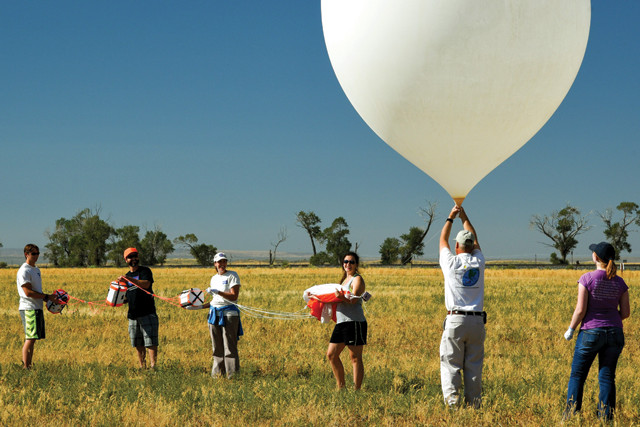
by Josh Knackert Tuesday, May 1, 2018

Teams of citizen scientists launched balloons carrying bacteria samples into the stratosphere during the solar eclipse, when some conditions approximated those on the surface of Mars. Pictured here is an earlier test launch by a team from Montana State University. Credit: Montana State University.
What does a total solar eclipse here on Earth have to do with studying life on Mars? The answer lies nearly 25 kilometers above Earth’s surface in the stratosphere, where the August 2017 eclipse offered researchers a rare opportunity to mimic conditions on the Red Planet.
“The stratosphere is similar in many ways to [the atmosphere at] Mars’ surface,” Angela Des Jardins, director of the NASA Eclipse Ballooning Project, said at a press conference at the fall meeting of the American Geophysical Union last December.
NASA researchers and their collaborators have previously conducted earthbound experiments to predict what kind of microscopic life could potentially grow in the inhospitable conditions on Mars, and which microorganisms could potentially hitchhike on spacecraft and colonize Mars.
Des Jardins described typical conditions in our stratosphere that are similar to Mars’ atmosphere, including low temperatures, pressures and water contents. A key difference between Mars and the stratosphere, however, is the amount of ultraviolet (UV) radiation and overall sunlight each receives.
“Light coming from the sun is very complex, making it difficult to replicate,” says David Smith, deputy branch chief of NASA’s Space Biosciences Research Branch and a collaborator on the Eclipse Ballooning Project. “The attenuated sunlight during a solar eclipse offers UV conditions that are likely closer to what is expected on Mars.”
To take advantage of the conditions provided by the 2017 total solar eclipse, NASA worked with dozens of citizen science teams across the country. The teams, comprising mostly high school and college students, launched a constellation of balloons along the eclipse’s path of totality, which in the U.S. stretched from Oregon to South Carolina. Thirty-four of these balloons included a thin aluminum strip that contained the Paenibacillus xerothermodurans bacterium.
This common soil bacterium was selected for a number of reasons: it forms spores, it can survive hot and dry extremes, and it is harmless to humans and the environment. Most importantly, numerous similar bacteria from the Paenibacillus genus have been swabbed off the floors of meticulously sterilized NASA clean rooms and even off sterilized pieces of spacecraft, indicating the bacteria’s knack for surviving incredibly harsh treatment.
“It’s important to understand the edge of habitability,” Smith says, “both how life as we know it lives on the margins and survivability of [bacterial] hitchhikers [during space travel].” This especially resilient bacterium thus makes a good study subject in experiments seeking to answer both questions, he says.
Researchers on the project are currently measuring the survival of P. xerothermodurans after exposure to Mars-like conditions on the balloons, and sequencing their genomes for potential mutations brought on by environmental stress. Identifying mutations could provide insights into which genes in these and other bacteria allow them to survive at the edge of habitability.
Findings from this project will be combined with previous and ongoing experiments. These and other bacteria and fungi are regularly sent up on balloons, treated with hostile compounds present on Mars in the lab, and exposed to microgravity and the stresses of space for months at a time on the International Space Station.
Such research can also help medical specialists understand how astronaut microbiomes might be affected by prolonged spaceflight and anticipate how bacteria could affect the first humans to set foot on the Red Planet.
The balloon project offered a rare and relatively inexpensive opportunity to engage citizen and student scientists in a large, seldom-possible research opportunity, Smith says. “Hopefully, we hooked a few people,” he adds. “The next generation is going to be essential for answering these questions” about habitability on Mars.
© 2008-2021. All rights reserved. Any copying, redistribution or retransmission of any of the contents of this service without the expressed written permission of the American Geosciences Institute is expressly prohibited. Click here for all copyright requests.